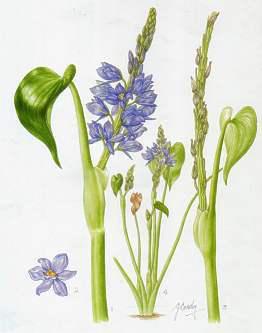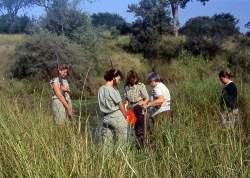Monochoria africana
Monochoria africana (Solms) N.E.Br.
Family: Pontederiaceae
Common names: there are no known common names for this rather rare plant
Introduction
Next time you go to the Kruger National Park, try to spot Monochoria africana, one of the most beautiful, rare, indigenous aquatic plants in southern Africa, far prettier and more interesting than any of the Big Five that also occur in the Kruger National Park. Believe it not, Monochoria africana belongs to the same family as the exotic water hyacinth, Eichhornia crassipes (C. Mart.), a notorious declared weed, and the declared invasive Pontederia cordata L. Both these plants have been very popular aquatic garden plants but because of their invasive habits have been lawfully banished from any garden in South Africa. All that is needed now is for someone to 'crack the germination and propagation code' of M. africana for it to become a 'hit' in every water feature in South Africa.

Description
Description
Monochoria africana is an annual (or perhaps sometimes perennial), erect, aquatic herb about 600-750 mm tall. The stems are short and corm-like, and the juvenile leaves are submerged, extremely variable in size and shape, scale-like to linear. Adult leaves are emergent, differentiated into petiole and blade; blade elliptic to ovate, up to ± 85-100 mm; petiole erect, ± 500 mm long.

The inflorescence is elongated, spike-like, with 20-40 ± equally spaced, blue flowers, and the peduncle is erect, 20-40 mm long. Petals 6, blue, 14.5-3.5 mm, persistent and enveloping ripe fruit. There are 6 stamens, of 2 kinds: 5 with simple filaments up to 5 mm long, and yellow, 1.8-4 mm long anthers. The sixth anther is blue, at least one quarter longer than the yellow ones with a longer filament (up to 5.5 mm long) and has an appendage attached to the filament that curls up along the side of the large blue anther. All six anthers arise from the perianth, opening by an apical pore, which later splits downwards. Capsules are ellipsoid to ovoid, ± 9 mm long; style 1.5-2.5 mm in fruit, opening by 3 valves but normally released as a unit and opening later. Seeds are numerous, ellipsoid to barrel-shaped, ± 0.75 mm long, with 10 narrow, longitudinal ribs or wings, dispersed in mud and by water.
Conservation Status
Status
Very little is known about Monochoria africana. It occurs sporadically in a localised area in South Africa as well as a few localised areas beyond our borders. The lack of information rather hampers an accurate assessment of this rare plant. According to Wendy Fowden, Manager of the Threatened Species Project, SANBI, M. africana is listed as 'Least Concern' at the moment.
Distribution and habitat
Distribution description
Monochoria africana has a fairly limited distribution in Mpumalanga Province, in the Kruger National Park of South Africa. The young plants are submerged in the water at the edge of the pan. As the plant grows, the water level drops and the adults grow along the marshy area of the pan. In 1997 while on holiday in the Kruger National Park, we were privileged to spot this plant in a small pan in the vicinity of Ngumulu Pan. At first glance its habitat and the shape of the leaves resembled that of our common arum lily, Zantedeschia aethiopica. Realising it had no white flowers, we stopped and studied the plant. To our delight we realised we were looking at Monochoria africana - partly the reason for coming to the Kruger Park! Sadly fellow tourists did not share our excitement; those who stopped behind us were annoyed when we told them it was a plant we were admiring. Also, that evening when asked by a fellow camper at Maroela campsite whether I had seen anything interesting, he was rather annoyed that I could get excited about finding a special plant!

Derivation of name and historical aspects
History
The genus Monochoria belongs to the family Pontederiaceae that consists of nine genera and 33 species. Five genera are from the New World (Pontederia, Reussia, Eurystemon, Hydrothrix and Zosterella), and two (Eichhornia and Heteranthera) from the New and Old Worlds. Monochoria and Scolleropsis are the only two genera from the Old World.
Monochoria is derived from two Greek words, mono, one, and choria, on its own or separate. The name could refer to the fact that when this genus was described it was the only one to occur in the Old World (Asia and Africa). The genus Scolleropsis from Africa was described later (Cook 1998), and it was therefore on its own in Asia and Africa. More likely it refers to the single, large, blue anther. The specific name refers to where the plant was collected, namely Africa.
The first Monochoria species to be collected in Africa was collected by Schweinfurth in 1869 in the Sudan and described by Solms-Laubach as M. vaginalis var. africana. Further research showed that it differed sufficiently from the Asian species of M. vaginalis, and was renamed M. africana ( Verdcourt 1961).
The first plant collected in South Africa was in 1937 by Stevenson-Hamilton, first warden of the Kruger National Park, at Gomonwane between Lower Sabie and Crocodile Bridge. Since then it has been collected five times: four times in the Kruger National Park in different pans between Lower Sabie and Olifants and Letaba camps in the Lebombo Mountains, and one record from outside the Park in Timbavati Private Game Reserve bordering the Kruger Park.
Ecology
Ecology
The flowers of Monochoria africana are dimorphic, that is in one flower the style will bend to one side and the large blue, fertile anther will bend in the opposite direction. The next flower will have an opposite arrangement, thereby creating mirror-images. Monochoria vaginalis has similar dimorphic flowers which face outwards. The showy yellow 'feeding' anthers attract the pollinators. When a pollinator lands on a flower to feed, the large blue 'fertile" anther touches the side of its body, thus depositing a small amount of pollen. On subsequently visiting a mirror-image flower, the pollinator's body brushes against the stigmatic area, effecting cross-pollination (Iyengar 1923). Bees tend to be the most common pollinating agents of the other species of Monochoria, but very little is known about the pollination biology of M. africana. A better understanding of its biology will perhaps explain the scarcity and sporadic appearance of this attractive species, which has the potential to become an indigenous African cultivated aquatic plant.
Uses
Use
In South Africa, Eichhornia crassipes (water hyacinth) is a declared weed and it may not be cultivated or traded. For several years, scientists at the Plant Protection Research Institute, Rietondale, Pretoria, have been doing extensive research on the biocontrol of Eichhornia crassipes. Before any biocontrol organism may be released in a country, it has to be exposed, under very strict quarantine, to all the native species that grow in the same habitat or are closely related to the invasive species. It is therefore essential that the native plants most closely related to the problem plant be used in such experiments. That is why so much emphasis has been placed on Monochoria africana, this beautiful but rather rare indigenous member of the Pontederiaceae.
Growing Monochoria africana
Grow
This plant has the potential to become a beautiful garden plant if only the 'germination code' could be deciphered. Each time the plants were collected, the seeds were sown in damp, river sand. Twice germination was successful, and plants flowered once and died, setting no seed. The seeds collected in 1997 started germinating, produced a lot of mucus around the embryo, and then died.
References
- Cook, C.D.K. 2004. Aquatic and wetland plants of southern Africa. Backhuys.
- Cook, C.D.K. 1998. Pontederiaceae. In K. Kubitzki, The families and genera of vascular plants, vol. IV, flowering plants to Monocotyledons Alismatanae and Commelinanae. Springer, Germany.
- Glen, R.P., Cook,C.D.K. & Condy,G. (Artist). 2001. Monochoria africana (Pontederiaceae). Flowering Plants of Africa 57: 10-15.
- Iyengar, M.O.T. 1923. On the biology of the flowers of Monochoria. Journal of Indian Botany 3: 170-173.
- Leistner, O.A. (ed.). 2000. Seeds plants of southern Africa : families and genera. Strelitzia 10. National Botanical Institute, Pretoria.
- Verdcourt, B. 1961. The genus Monochoria Presl (Pontederiaceae) in Africa. Kirkia 1: 80-83.
Credits
René Glen
KwaZulu-Natal Herbarium
July 2006
Plant Attributes:
Plant Type: Aquatic
SA Distribution: Limpopo, Mpumalanga
Soil type:
Flowering season:
PH:
Flower colour: Blue
Aspect:
Gardening skill:
Special Features:
Horticultural zones








Rate this article
Article well written and informative
Rate this plant
Is this an interesting plant?
Login to add your Comment
Back to topNot registered yet? Click here to register.